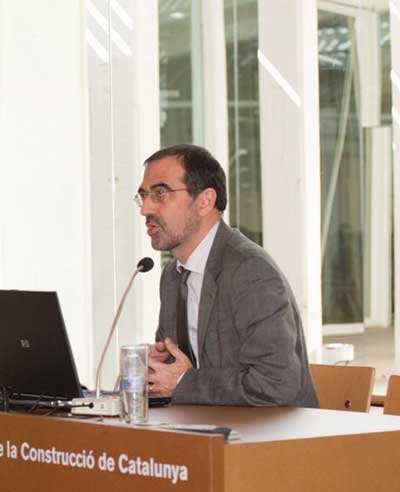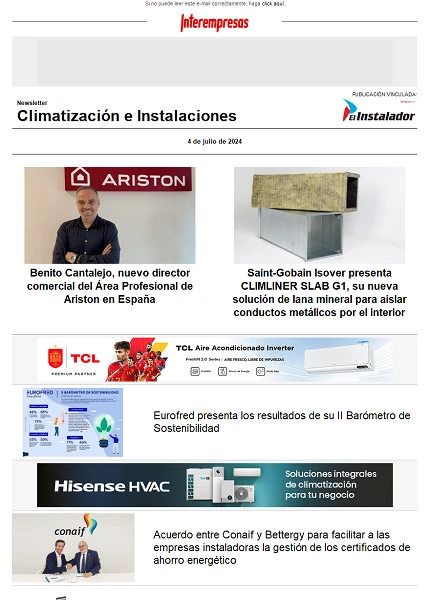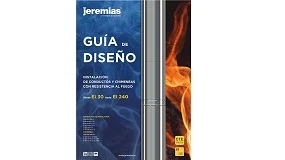"With this directive, for the first time, makes participant to the end-user of the buildings through an understandable information for him"
February 14, 2008
On October 31 was started in the new directive energy efficiency applicable to all newly constructed buildings. Josep Solé, actively involved in this topic and a member of the Group of experts who have made the monitoring of the development of the functions of drafting the technical building code (CTE) and the energy rating, reels to Interempresas information on such legislation.
The energy efficiency directive entered into force on 31 October. What balance can make these two months since the implementation of the standard?
Still no real impact on the sector has obviously not been detected in these first months, but yes they have begun to notice actions by some administrations autonomous to begin to implement the registration procedures, as well as some actions of awareness-raising and training level professional schools, and very little else. In general, we can say that the procedure is moving, albeit with much difficulty and slowly.
Tell us a little bit of such legislation. What it is? What or who goes?
The regulation sets that all buildings in new construction, as well as meet the minimum requirements established by the (essential so that a building is legal) technical code, should be available also an evaluation and qualification from a point of view of energy efficiency (through a graphical scale from the 'A')more efficient, up to the 'G' (less efficient). This evaluation is carried out in two phases: the first is at the project level and is confirmed or modified later with the Final Certificate of work.
This initiative is directed primarily to users so they have a clear, objective and discriminating information on energy efficiency of buildings which are intended to buy. For this reason, the information is mandatory in all promotional documents, offers, contracts, etc. In the second instance, with the rules intended to promote the transparency of the real estate market and as an element of different promotions. Lastly, it involves the technical project and construction of buildings in the process of achieving more efficient buildings from an energy point of view.
What benefits for the environment provides the directive?
Increased energy efficiency of buildings represents a net decrease of the energy consumed by them and, consequently, a reduction of environmentally harmful effects of the waste of energy, mainly on the responsible for the greenhouse effect of CO2 emissions. It should not be forgotten that at European level buildings consume 40 per cent of the total energy consumed (rather than the industrial sector or transport).
What does for the construction sector the application of such legislation?
Apart from the purpose of improving the quality of construction and the impact on the environment, the implementation of this EU directive is for the first time becomes involved to the end user of the buildings through an understandable information for him.
Buildings account for 40 per cent of the total of European energy demand. What role does the construction in environmental equilibrium play?
It is clear that the buildings play a key role since they are the largest consumers of energy (rather than the industry or transport). On the other hand the buildings are very long life cycle goods so non-consideration today of the environmental aspects involved a 'mortgage ecology' impractical for future years.
The new energy efficiency directive complements CTE. What are the advantages of the technical building code for the sector?
The CTE is the minimum level of reference to the energy rating of buildings. It is assuming a shock for the building sector in Spain was based on regulations of the 70 and 80 years. It is leading to the beginning of a process of analysis and updating of the sector which should aim towards improving systems and processes of the construction. The started path is long and not without difficulties but absolutely essential.
What role should the Administration have in this type of policy?
Central, regional administrations and local must guarantee and promote these initiatives that are implemented and developed properly. In this regard, it must be all the means and resources to make this possible. Furthermore, they must be exquisite in the buildings in which involved, either directly as promoters or through aid, grants, plans of action, conventions, etc. Unfortunately, in many cases administrations tend to adopt a 'passive' rather than 'proactive' role and 'exemplary' for the rest of the sector.
What is the situation of the construction industry today? What are the main problems and demands facing the sector?
The construction sector is a deeply unchanging sector, with a very strong technical inertia. One of the main challenges is to ensure that the sector is so dynamic and agile as required by the times and that it incorporate the new challenges of society (quality, environmental aspects, industrialisation, competitiveness, etc.). On the other hand, one of the challenges that occurs in Spain in the short or medium term is to adapt a huge housing stock (built in the back boom of recent years) to the requirements of current users, since when they were already built they did not give satisfaction to them. Unfortunately for the users and the environment, these initiatives (CTE, energy efficiency, etc.) have delayed both in its implementation that had not arrived in time to include many millions of homes that have been built in recent years.
As Technical Director of Iberian Ursa insulation, what are the objectives to achieve now?
Ursa aims to establish itself as the 'technical reference' in the field of the thermal and acoustic protection of buildings and begin to deepen strictly within the scope of the environmental impact of construction products to become, in this areaa leading companies of the sector.
Josep Solé.
Related Companies or Entities
Ursa Ibérica Aislantes, S.A.

















































































